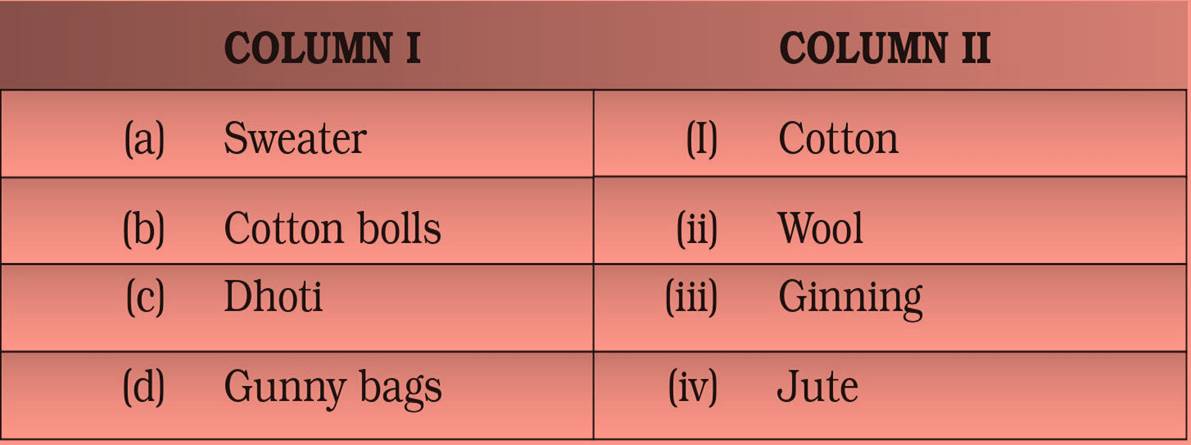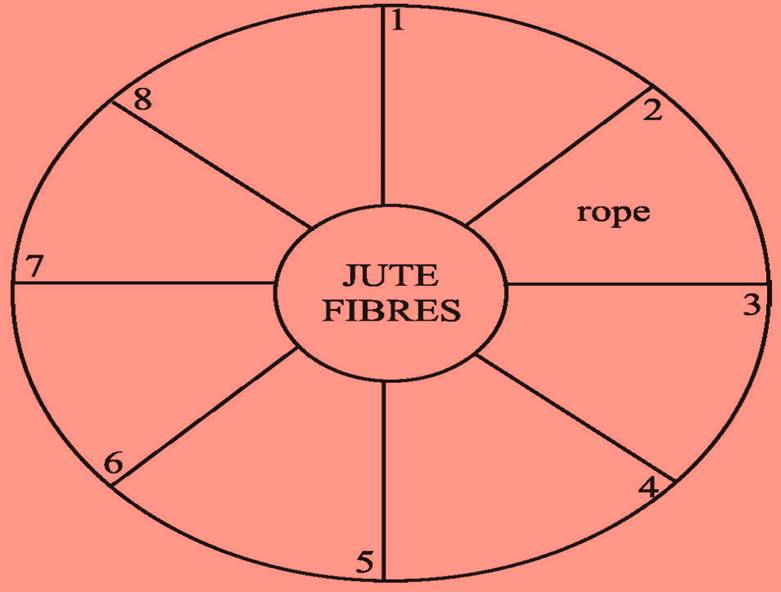Science
(www.olympiadsuccess.com)
Chapter 3: Fibre to Fabric
Class: VI
Exemplar Solutions
Multiple Choice Questions
Question 1
Paheli wants to present her friend a gift made of plant-fibre. Which out of the following will she select?
(a) Jute bag
(b) Woollen shawl
(c) Silk saree
(d) Nylon scarf
Answer 1
(a)
Question 2
Which statement out of the following is incorrect?
(a) Use of Charkha was popularized by Mahatma Gandhi as a part of the Independence Movement.
(b) In India, jute is mainly grown in Kerala and Punjab.
(c) To make fabric, the fibres are first converted into yarns.
(d) Sufi saint Kabir was a weaver.
Answer 2
(b)
Question 3
Which of the following materials did people use in ancient times for making clothes?
(i) Leaves of trees
(ii) Newspaper
(iii) Metal foils
(iv) Animal skins and furs
(a) (i) and (ii) (b) (i) and (iii)
(c) (ii) and (iii) (d) (i) and (iv)
Answer 3
(d)
Question 4
Which of the following is not a natural fibre?
(a) Cotton
(b) Jute
(c) Nylon
(d) Flax
Answer 4
(c)
Question 5
Which set of substances is not used for making fibres?
(a) Silk, chemicals
(b) Yak hair, camel hair
(c) Husk, bones
(d) Flax, wool
Answer 5
(c)
Question 6
Boojho went to a cloth shop. There he found a fabric which was smooth to touch, had vibrant colour and shine. The fabric could be
(a) Cotton
(b) Wool
(c) Silk
(d) Jute
Answer 6
(c)
Question 7
Which part of the jute plant is used for getting jute fibre?
(a) Flower
(b) Stem
(c) Fruit
(d) Leaf
Answer 7
(b)
Question 8
Yarn is woven to get fabric using
(a) charkha
(b) spinning machines
(c) looms
(d) knitting needles
Answer 8
(c)
Question 9
Beera is a farmer. His field has black soil and the climate is warm. Which fibre yielding plant should he grow in his field?
(a) Jute
(b) Cotton
(c) Coconut
(d) Wool
Answer 9
(b)
Question 10
The correct sequence to get cloth is :
(a) fibre®fabric®yarn
(b) fibre®yarn®fabric
(c) fabric®yarn®fibre
(d) yarn®fibre®fabric
Answer 10
(b)
Question 11
Boojho wants to make yarn from fibre at home. Which of the following will he use to carry out the task?
(a) Power loom
(b) Handloom
(c) Charkha
(d) Knitting needles
Answer 11
(c)
Very Short Answer Questions
Question 12
Yarn, fabric and fibres are related to each other. Show the relationship by filling the blanks in the following sentence.
Fabric of cotton saree is made by weaving cotton_ _ _ _ _ _which in turn is made by spinning thin cotton _ _ _ _ _ _.
Answer 12
Yarn, fibres.
Question 13
Some terms related to fabrics are jumbled up and given below.
Write them in their correct form.
(a) onttoc (b) sinnping
(c) vingwea (d) bisref
Answer 13
(a) cotton (b) spinning
(c) weaving (d) fibres
Question 14
State whether the following statements are true or false. If false, correct them.
(a) Silk is a plant fibre.
(b) Jute is obtained from the leaves of a plant.
(c) Weaving is a process of arranging two sets of yarn together.
(d) Cotton yarn on burning gives an odor similar to that of a burning paper.
Answer 14
(a) False (b) False
(c) True (d) True
Correct statements
(a) Silk is an animal fibre.
(b) Jute is obtained from the stem of a plant.
Question 15
The following is an answer given by Boojho to a question asked by his teacher— "Cotton, wool, silk and jute are classified as natural fibres whereas nylon and polyester are classified as synthetic fibres."
Can you tell what question the teacher has asked?
Answer 15
Classify the following fibres as natural and synthetic.
Polyester, Jute, Silk, Nylon, Cotton, Wool
Question 16
Once, Paheli visited a tailor shop and brought home some cuttings of fabric to study their properties. She took two pieces and found that one of the pieces was shrinking when it was burnt with a candle. However the other did not shrink on burning. Can you help her to find out which of the two was a cotton fabric and which a silk fabric?
Answer 16
Cotton fabric does not shrink but silk fabric shrinks on burning.
Question 17
One way of making fabric from yarn is weaving, what is the other?
Answer 17
Knitting.
Short Answer Questions
Question 18
Boojho with perfect eyesight was finding it difficult to pass a thread through the eye of a needle. What can be the possible reason for this?
Answer 18
The end of the thread was separated into a few thin strands or the thread was quite thick.
Question 19
In ancient times stitching was not known. People used to simply drape the fabrics around different parts of their body. Even today a number of unstitched fabrics are used by both men and women. Can you give four such examples of clothes?
Answer 19
Saree, dhoti, lungi, turban, dupatta, towel, etc.
Question 20
Match the articles given in Column I with the articles of Column II

Answer 20
(a) – (ii) (b) – (iii) (c) – (i) (d) – (iv)
Question 21
Fill in the blanks to complete the life story of cotton fibre.
My parents, cotton plants were grown in _______soil and _____- climate. The plants bore fruits called ______ . I, the cotton fibre was separated from seeds in the cotton bolls by the process of ______. Other cotton fibres and myself were made into yarn by the process of ______. The yarn was _______to give beautiful colors and then _______ to get cotton fabric.
Answer 21
Black, warm, cotton bolls, ginning, spinning, dyed, woven
Question 22
Match the terms given in Column I with the statements given in Column II.
Column I Column II
(a) Weaving (i) A single yarn used to make a fabric
(b) Knitting (ii) Combing of cotton fibres to remove seeds
(c) Spinning (iii) Yarns are made from these thin strands
(d) Ginning (iv) These are spun from fibres and then used to
make fabrics
(e) Fibre (v) Process of arranging two sets of yarns
together to make a fabric
(f) Yarn (vi) Process of making yarn from fibres
Answer 22
a – (v), b – (i), c – (vi), d – (ii), e – (iii), f – (iv)
Question 23
Fill in the names of useful items made from jute fibres in Fig. 3.1. One such example is given.

Fig.3.1
Answer 23
Fabric, jewellery, hand-bag, carpet, mattress, gunny bag, cap or any other.
Long Answer Questions
Question 24
A cotton shirt, before it reaches you, completes a long journey. Elaborate this journey starting from cotton bolls.
Answer 24
Cotton bolls®Cotton yarn®Cotton fabric®Cotton shirt
Question 25
Describe the two main processes of making fabric from yarn.
Answer 25
Describe weaving and knitting.
Yearlong program for Olympiads preparation & to build necessary skills for future.
Explore More
Time to mark your calendar with the upcoming Olympiads exam schedule.
Explore More
Take your Olympiad preparation to next-level by taking LIVE Classes.
Explore More
Assess your performance by taking topic-wise and full length mock tests.
Explore More
Online tuitions for international compeitions like SASMO, SEAMO, etc for Grades 1-11.
Explore More